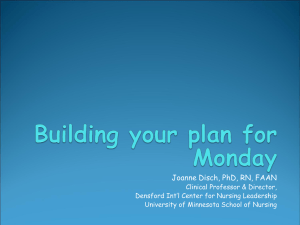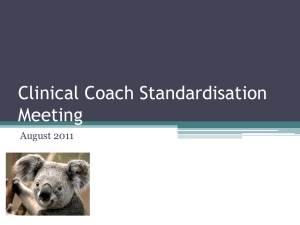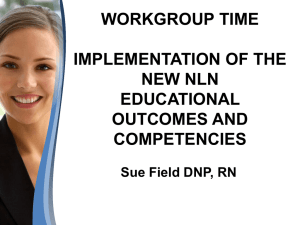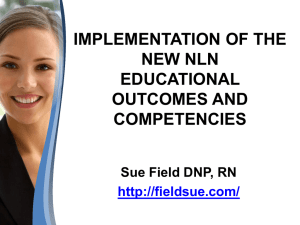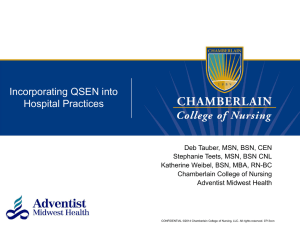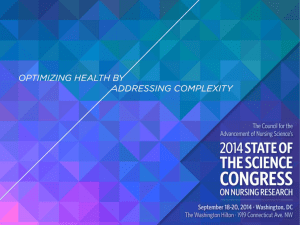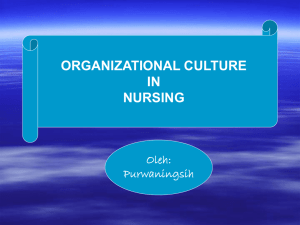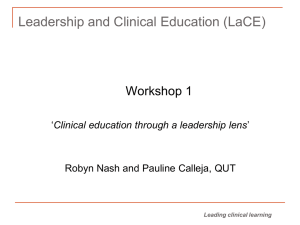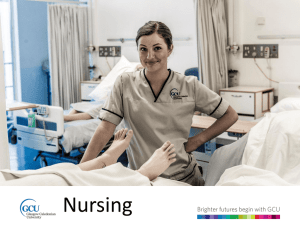Incorporating NLN Framework into your Nursing
advertisement
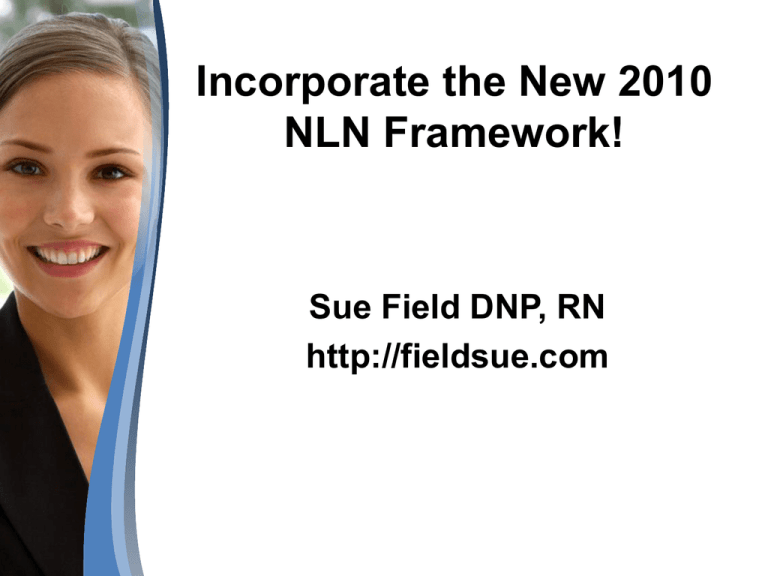
Incorporate the New 2010 NLN Framework! Sue Field DNP, RN http://fieldsue.com Objectives: Attendees will • Analyze methods to – implement core values, integrating concepts, and program learner outcomes of the 2010 NLN Educational Competencies Model into a nursing program. • Formulate a plan to – facilitate faculty group involvement in the implementation of the 2010 NLN Educational Competencies Model. Journey to the Templates 1. NLNAC Initial Accreditation Less than desirable Framework 2. Consultants – June Larson: Chair of the NLN Outcomes and Competencies Committee – Denise Hirst: Project Manager for QSEN 3. Presentation at the NLN National Conference 2011 4. 6 hour workshop in North Carolina in March 2012 5. Article written for publication National Standards • IOM (Institute of Medicine) report in 2003 • IOM report in 2011 • QSEN (Quality Safety Education in Nursing) 2005 – 5 outcomes of IOM + Safety National Standards • Carnegie Study: – Educating Nurses a Call for Radical Transformation: Benner, Sutphen, Leonard & Day (2010) • NLN Outcomes and Competencies (2010) • Benner’s article last month – Knowledge – Practice (Skills) – Ethical Component (Attitude) NLN Framework Purchase • National League for Nursing. (2010). Outcomes and competencies for graduates of practical/vocational, associate degree, baccalaureate, master’s, practice doctorate, and research doctorate programs in nursing. NLN. • http://www.nln.org/facultydevelopmen t/competencies/index.htm Student Learner Outcomes 1. 2. 3. 4. Human Flourishing Nursing Judgment Professional Identify Spirit of Inquiry Professional Identity Student Learner Outcomes PN to PhD PN/VOC Assess how one’s personal strengths and values… ADN/ DIP BS MASTER PRACTICE RESEARCH DOC DOC Implement Express Implement As a nurseone’s role one’s one’s scholar, seek as a nurse identity advanced ways to in ways… as a practice translate nurse … role… research findings into practice… Implement one’s role as a research scholar committed … Human Flourishing Practical Nursing Program Programs Learner Learner Outcomes Outcomes Promote the human dignity, integrity, self determination, Human and personal Flourishing growth of patients, oneself, and members of the health care team. Associate Degree Nursing Programs Learner Outcomes Advocate for patients and families in ways that promote their selfdetermination, integrity, and ongoing growth as human beings. Nursing Judgment Practical Nursing Program Programs Learner Outcomes Learner Outcomes Associate Degree Nursing Programs Learner Outcomes Provide a rationale for judgments used in the provision of safe, quality care and Nursing for decisions that Judgment promote the health of patients within a family context. Make judgments in practice, substantiated with evidence, that integrate nursing science in the provision of safe, quality care and that promote the health of patients within a family and community Professional Identity Program Learner Outcomes Practical Nursing Programs Associate Degree Nursing Programs Learner Outcomes Learner Outcomes Assess how one’s personal strengths and values affect one’s identity as a Professional nurse and one’s contributions as a Identity member of the health care team. Implement one's role as a nurse in ways that reflect integrity, responsibility, ethical practices, and an evolving identity as a nurse committed to evidence-based practice, caring, advocacy, and safe, quality care for Spirit of Inquiry Practical Nursing Program Programs Learner Learner Outcomes Outcomes Question the basis for nursing actions, Spirit considering research, of evidence, tradition, and Inquiry patient preferences. Associate Degree Nursing Programs Learner Outcomes Examine the evidence that underlies clinical nursing practice to challenge the status quo, question underlying assumptions, and offer new insights to improve the quality of care for patients, families, and communities. QSEN Outcomes (2005) • 1. QSEN: Patient Centered Care Student will recognize the patient or designee as the source of control and full partner in providing compassionate and coordinated care based on respect for patient's preferences, values, and need • 2. QSEN: Safety Student will minimize risk of harm to patients and providers through both system effectiveness and individual performance. QSEN Outcomes… • 3. QSEN: Informatics The student will use information and technology to communicate, manage knowledge, mitigate error, and support decision making. • 4. QSEN: Teamwork and Collaboration Student will function effectively within nursing and inter-professional teams, fostering open communication, mutual respect, and shared decision-making to achieve quality patient care. QSEN Outcomes… • 5. QSEN: Quality Improvement • Student will use data to monitor the outcomes of care processes and use improvement methods to design and test changes to continuously improve the quality and safety of health care systems. • 6. QSEN: Evidence Based Practice • Student will integrate best current evidence with clinical expertise and patient/family preferences and values for delivery of optimal health care. QSEN and NLN Competencies and Outcomes • NLN: Human Flourishing – QSEN: Patient Centered Care • NLN Nursing Judgment – QSEN: Safety – QSEN: Informatics • NLN Personal/Professional identity – QSEN: Teamwork and Collaboration • NLN Spirit of Inquiry – QSEN: Quality Improvement – QSEN: Evidence Based Practice NAPNES PN Student Learner Outcomes • From NAPNES – May 6, 2007 – 5 years old • Need to be up to date with latest standards including –QSEN –NLN Outcomes and Competencies NAPNES PN Outcomes (2007) 1. Demonstrate professional behaviors of accountability and professionalism according to the legal and ethical standards for a competent licensed practical/vocational nurse. 2. Effectively communicate with patients, significant support person(s), and members of the interdisciplinary health care team incorporating interpersonal and therapeutic communication skills. NAPNES… 3. Collect holistic assessment data from multiple sources, communicate the data to appropriate health care providers, and evaluate client responses to interventions. 4. Collaborate with the registered nurse or other members' of the health care team to organize and incorporate assessment data to plan/ revise patient care and actions based on established nursing diagnoses, nursing protocols, and assessment and evaluation data. NAPNES… 5. Demonstrate a caring and empathic approach to the safe, therapeutic, and individualized care of each client 6. Implement patient care, at the direction of a registered nurse, licensed physician or dentist through performance of nursing interventions or directing aspects of care, as appropriate, to unlicensed assistive personnel (UAP). Missing from NAPNES • 1. Patient Centered Care and Human Flourishing • 2. Quality Improvement and Spirit of Inquiry • 3. Informatics • 4. Evidence Based Practice/Research • 5. Safety: Mitigate errors • 6. Nursing Judgment NLN 2000 AD Learner Outcomes • 1. Practice within the ethical, legal and regulatory framework of nursing and standards of nursing practice. • 2. Demonstrate caring behaviors toward the patient, significant support persons and members of the health care team • 3. Demonstrate accountability for nursing care given by self and or delegated to others. NLN 2000 AD Learner Outcomes • 4. Utilize therapeutic communication skills in professional relationships. • 5. Utilize the nursing process to provide individualized nursing care in diverse settings. • 6. Utilize critical thinking to make clinical judgments and management decisions to provide safe, appropriate and individualized care. NLN 2000 AD Learner Outcomes • 7. Develop individualized teaching plans based on assessed patient needs. • 8. Collaborate with the patient, support persons, as well as members of the healthcare team to assist the patient to achieve optimal outcomes. • 9. Develop personal goals for professional development and participate in lifelong learning. Missing from 2010 NLN • 1. Patient Centered Care and Human Flourishing • 2. Quality Improvement and Spirit of Inquiry • 3. Informatics • 4. Evidence Based Practice/Research • 5. Safety: Mitigate errors • 6. Nursing Judgment Course Templates • http://fieldsue.com • Templates at website above. 1st Step Course Outcomes • 1. List the Course Outcomes – A. Identify the learning activities – B. Identify the measurements – C. Identify the student learner outcomes are related to the course outcomes. Course Outcomes • Example of Outcomes to Assignments 1. The Core Values 1. Present in your Philosophy Statement 2. Flow through your Curriculum Core Values Template Example 2. Integrating Concepts • NLN outcomes and competencies book (2010) • Suggested statements are listed – for EACH of the 6 integrating concepts 1. Context and Environment 2. Knowledge and Science 3. Personal/Professional Development 4. Quality and Safety 5. Relationship Centered Care 6. Teamwork Three Apprenticeships • Knowledge • Practice Know How • Ethical Comportment – Benner: Do away with curricular threads and implement 3 apprenticeships Integrating Concepts Three Apprenticeships 1. Context and Environment – – – Knowledge Practice Know How Ethical Comportment 2. Knowledge and Science – – – Knowledge Practice Know How Ethical Comportment 3. Personal/Professional Development – – – Knowledge Practice Know How Ethical Comportment 4. Quality and Safety – – – Knowledge Practice Know How Ethical Comportment 5. Relationship Centered Care – – – Knowledge Practice Know How Ethical Comportment 6. Teamwork – – – Knowledge Practice Know How Ethical Comportment Integrating Concepts Template Example Program Learner Outcomes • Needs to meet National Standards • NAPNES from 2007 does not include national standards • QSEN and NLN Framework QSEN and NLN Competencies and Outcomes • • • • • • QSEN Patient Centered Care Safety Informatics Teamwork and Collaboration Quality Improvement Evidence Based Practice NLN • Human Flourishing • Nursing Judgment • Personal/Professional identity • Spirit of Inquiry Student Learner Outcomes • Need to demonstrate that EVERY student that graduates has fulfilled the student learner outcomes. • Clinical/Program Portfolio is a great way to prove this. Student Learner Outcomes Template 1 Student Learner Outcomes Template 2 “How To’s” Steps that might work for you and your nursing program How to: Part I • PAIR faculty members – Who teach the same courses • Determine for each course outcome – How the course outcome relates to the program outcomes – Determine the learning activities for the outcome and – Determine the measurements used for the outcome • See template next slide How to: Part I Course Template How to: Part II Round Robin • Arrange tables by integrating concepts – Attach template to tables by integrating concepts • Faculty pairs rotate through the stations. – Faculty identify the course outcomes that fulfill competencies listed Context and Environment Relationship Centered Care Teamwork 3 Apprenticeships for each: Knowledge and Science Knowledge Practice Ethical Comportment Personal Professional Growth Quality and Safety Part III: Compilation • Compile all information on one document Part IV: Program Learner Outcomes • Complete the Program Learner Outcomes Template – in a round robin – similar to the Integrating Concepts Round Robin Human Flourishing Spirit of Inquiry Nursing Practice Nursing Judgment Professional Identify Part V: Identify Apprenticeships Missing Course Outcomes • Identify apprenticeships that lack course outcomes. – Develop new course outcomes as needed • Identify the new outcomes needed – Evaluate BOTH the Apprenticeships AND the Learner Outcomes Templates – Be careful of Additive curriculum » (May need to take something out of your curriculum) • Develop learning activities for each • Develop outcome measures for each Templates • • • • • Template A: Template 1. Template 2. Template 3. Template B: Course Templates Core Competencies Integrating Concepts Learner Outcomes Program Portfolio References • • • • • • • • Benner, P., Sutphen, M, Leonard-Kahn, V., Day, L. (2008, September). Formation and everyday ethical comportment. American Journal of Critical Care,17(5473), 473-476. Benner, P., Sutphen, M, Leonard-Kahn, V., Day, L. (2010). Educating nurses a call for radical transformation. San Francisco, CA: Jossey-Bass. Benner, P., Tanner, C., Chesla, C. (2009). Expertise in nursing practice. (2nd ed.). NY: Springer Publishing. Caputi, L. (2010). Teaching nursing: The art and science. (2nd ed.).Glen Ellyn, IL: College of DuPage Press. Cronenwett, L., Sherwood, G., Barnsteiner, J., Disch, J., Johnson, J., Mitchell, P, & Warren, J. (2007). Quality and safety education for nurses. Nursing Outlook, 55(3), 122-131. Hirst, D. & Foster, B. (2009). Undergraduate curriculum mapping: Faculty interactive approach using QSEN competencies. Poster presentation. (Template modeled after Hirst & Foster’s work). National League for Nursing. (2010). Outcomes and competencies for graduates of practical/vocational, associate degree, baccalaureate, master’s, practice doctorate, and research doctorate programs in nursing. NLN. http://www.nln.org/facultydevelopment/competencies/index.htm QSEN Quality and Safety Education for Nurses. http://www.qsen.org • Questions??? • http://fieldsue.com/
